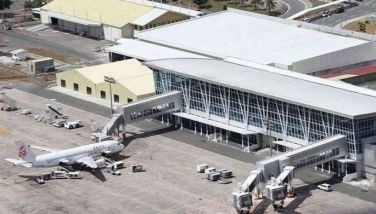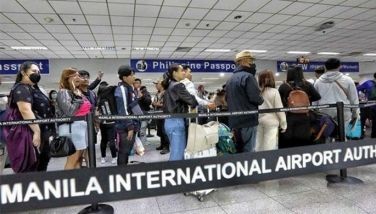For peace in Sulu

December 29, 2005 | 12:00am
Responding to the urgent calls for action relative to the renewed conflict in Sulu, the Mindanao People’s Peace Movement (MPPM) sent an 11-person peace mission to Mindanao December 19-26 to help bring about a just end to the conflict in the southern island. The MPPM is a tri-people, grassroots or community-based alliance and coalition of human rights and peace groups as well as non-government and peoples’ organizations, churches, schools and other institutions committed to the pursuit of genuine and lasting peace in Mindanao, Sulu, Basilan, Tawi-Tawi and Palawan (MinSuBaTaPa).
The team had conversations with government officials, members of the Moro National Liberation Front, the military, church people and civil society and the Peace Advocates of Zamboanga. The objective was to assess the extent of the damage to families and communities in the areas affected by the recent armed conflict in Sulu last month; find evidences of alleged violations of human rights before and during the conduct of the military operations; discuss how the conflict began and what might be its root causes, and form an MPPM organizing group in Sulu.
Al Senturias, head of MPPM, sent me the mission team’s summary report and recommendations. The major findings may not please military people in Sulu, but these were what the team found out.
First, the Armed Forces of the Philippines (AFP) had been sufficiently made aware of the presence of the MNLF forces in the area (Mt. Tumatangis in Indanan) the AFP troops were intending to pass on November 11, allegedly in pursuit of elements of the Abu Sayyaf Group (ASG), thus igniting the current conflict. Mt. Tumatangis, in fact, is known to be the base camp of MNLF state chair Khaed Ajibon.
A serious finding was that on the first day of the Week of Peace in Mindanao, on November 24, while Brig. Gen. Alexander Aleo, head of Task Force Comet, was addressing the mission team in the municipal hall plaza of Sulu, four planes were seen dropping bombs in the general direction of Bwansa, Indanan.
The report said that the terms Misuari Breakaway Group (MBG) or Misuari Renegade Group (MRG) were coined either by the AFP or the media to refer to those groups the military have been fighting with in February and in November. It is common knowledge among the people the mission team interviewed that the so-called MBG or MRG elements are, in fact, mujahideens of the MNLF. Thus the current conflict is a flagrant violation of the Final Peace Agreement signed by the MNLF and the Government of the Republic of the Philippines.
While confirming the presence of the Abu Sayyaf Group in Sulu, the report said, the MNLF as well as ordinary citizens and public officials condemn the Abu Sayyaf’s criminal activities.
The findings included the Suluanons’ opposition to the presence of American troops in their area, the question of lack of mechanism for the systematic and effective investigation of human rights, distrust of the military, and a strong citizens’ movement capable of working with the local government units, the police and the military in building a peaceful, orderly and progressive society in Sulu.
The mission team’s recommendations fall into short term (12 months or one year), medium-term (two to three years) and long-term (four to seven years) categories.
Under the short-term, the urgent call is for the release of Nur Misuari, former governor of the Autonomous Region of Muslim Mindanao (ARMM) and leader of the MNLF.
Among the recommendations are a call for a three to six-month truce to enable concerned groups and local government units to render relief and rehabilitation assistance to displaced communities, as well as the government’s declaring of the whole year of 2006 as Year of Peace in Sulu; the formation of a Tripartite Monitoring Committee to be composed of the Organization of the Islamic Conference (OIC), and representatives of the GRP and MNLF to review and evaluate the implementation of the provisions of the 1966 Final Peace Agreement.
The medium-term recommendation calls for the gradual pulling out of the AFP contingent in Sulu within two to three years and at the same time enhancing the capacity of the Sulu Philippine National Police. Senturias says, "While some people appreciate the contribution of the military in responding to the problems of the people in Sulu, a great many desire the immediate pullout of the entire AFP contingent in Sulu in order to prevent the breaking out of new hostilities between the GRP and the MNLF that have caused havoc and destruction of properties and massive displacement of families and communities, especially the loss of lives on both sides of the warring camps."
The long-term recommendation has to do with addressing directly the root of the present predicament in Sulu/Tawi-Tawi and Basilan and the other Bangsamoro areas in Mindanao and Palawan, i.e. the question of the right to self-determination of the Bangsamoro.
As the mission group relates it, centuries before the coming of the Spaniards, the Bangsamoro enjoyed political independence through the Sultanate of Maguindanao and the Sultanate of Sulu and North Borneo that conducted diplomatic relations with China and other nations. The Bangsamoro zealously and valiantly defended their independence under the two Bangsamoro sultanates during the Spanish colonial period. But Mindanao, Sulu and Tawi-Tawi as well as Basilan were ceded by Spain to the United States of America under the Treaty of Paris on Dec. 10, 1898.
While the Bangsamaro gallantly resisted American rule in the beginning, they became gradually absorbed by the colonial Philippine state. Nevertheless, through various armed and legal opposition, they manifested their distaste for Philippine rule. The Bangsamoro leaders, through petitions to the President of the United States, indicated their desire not to be annexed as territories of the Philippines.
It is within the context of opposition to being part of the Philippine government that the MPPM, according to Senturias, "takes the view that the strategic solution to the Bangsamoro question/problem is to address the historical injustice foisted upon the Bangsamoro when they were annexed to the Philippines without their plebiscitary consent. MPPM, therefore, has been proposing since December 2002 the conduct of a United Nations-Managed Referendum to settle once and for all the issue of whether the Bangsamoro would like to remain with the Philippines or become an independent state."
The MPPM will hold a follow-up to its mission to Sulu with another one March 1-5, 2006, and with a solidarity conference sponsored by the PeaceWeavers of which MPPM is a part, on March 6, and a climb to Bud Dajo on March 7, to commemorate the 100th year of the Bud Dajo Massacre. The culminating activity is the MPPM Bangsamoro Peace Summit on March 8-11.
The Bud Dajo massacre took place March 6, 1906 when 800 American soldiers with superior weapons attacked Bud Dajo or Mt. Dajo, killing more than 1,000 men, women and child. The war took place after the abrogation of the Kiram-Bates Treaty and was pursued by Leonard Wood, first American governor to the Moro Province who inaugurated the tragic Moro-American War which began at the turn of the 20th Century and claimed 3,000 Muslim lives.
My e-mail: [email protected]
The team had conversations with government officials, members of the Moro National Liberation Front, the military, church people and civil society and the Peace Advocates of Zamboanga. The objective was to assess the extent of the damage to families and communities in the areas affected by the recent armed conflict in Sulu last month; find evidences of alleged violations of human rights before and during the conduct of the military operations; discuss how the conflict began and what might be its root causes, and form an MPPM organizing group in Sulu.
Al Senturias, head of MPPM, sent me the mission team’s summary report and recommendations. The major findings may not please military people in Sulu, but these were what the team found out.
First, the Armed Forces of the Philippines (AFP) had been sufficiently made aware of the presence of the MNLF forces in the area (Mt. Tumatangis in Indanan) the AFP troops were intending to pass on November 11, allegedly in pursuit of elements of the Abu Sayyaf Group (ASG), thus igniting the current conflict. Mt. Tumatangis, in fact, is known to be the base camp of MNLF state chair Khaed Ajibon.
A serious finding was that on the first day of the Week of Peace in Mindanao, on November 24, while Brig. Gen. Alexander Aleo, head of Task Force Comet, was addressing the mission team in the municipal hall plaza of Sulu, four planes were seen dropping bombs in the general direction of Bwansa, Indanan.
The report said that the terms Misuari Breakaway Group (MBG) or Misuari Renegade Group (MRG) were coined either by the AFP or the media to refer to those groups the military have been fighting with in February and in November. It is common knowledge among the people the mission team interviewed that the so-called MBG or MRG elements are, in fact, mujahideens of the MNLF. Thus the current conflict is a flagrant violation of the Final Peace Agreement signed by the MNLF and the Government of the Republic of the Philippines.
While confirming the presence of the Abu Sayyaf Group in Sulu, the report said, the MNLF as well as ordinary citizens and public officials condemn the Abu Sayyaf’s criminal activities.
The findings included the Suluanons’ opposition to the presence of American troops in their area, the question of lack of mechanism for the systematic and effective investigation of human rights, distrust of the military, and a strong citizens’ movement capable of working with the local government units, the police and the military in building a peaceful, orderly and progressive society in Sulu.
The mission team’s recommendations fall into short term (12 months or one year), medium-term (two to three years) and long-term (four to seven years) categories.
Under the short-term, the urgent call is for the release of Nur Misuari, former governor of the Autonomous Region of Muslim Mindanao (ARMM) and leader of the MNLF.
Among the recommendations are a call for a three to six-month truce to enable concerned groups and local government units to render relief and rehabilitation assistance to displaced communities, as well as the government’s declaring of the whole year of 2006 as Year of Peace in Sulu; the formation of a Tripartite Monitoring Committee to be composed of the Organization of the Islamic Conference (OIC), and representatives of the GRP and MNLF to review and evaluate the implementation of the provisions of the 1966 Final Peace Agreement.
The medium-term recommendation calls for the gradual pulling out of the AFP contingent in Sulu within two to three years and at the same time enhancing the capacity of the Sulu Philippine National Police. Senturias says, "While some people appreciate the contribution of the military in responding to the problems of the people in Sulu, a great many desire the immediate pullout of the entire AFP contingent in Sulu in order to prevent the breaking out of new hostilities between the GRP and the MNLF that have caused havoc and destruction of properties and massive displacement of families and communities, especially the loss of lives on both sides of the warring camps."
The long-term recommendation has to do with addressing directly the root of the present predicament in Sulu/Tawi-Tawi and Basilan and the other Bangsamoro areas in Mindanao and Palawan, i.e. the question of the right to self-determination of the Bangsamoro.
As the mission group relates it, centuries before the coming of the Spaniards, the Bangsamoro enjoyed political independence through the Sultanate of Maguindanao and the Sultanate of Sulu and North Borneo that conducted diplomatic relations with China and other nations. The Bangsamoro zealously and valiantly defended their independence under the two Bangsamoro sultanates during the Spanish colonial period. But Mindanao, Sulu and Tawi-Tawi as well as Basilan were ceded by Spain to the United States of America under the Treaty of Paris on Dec. 10, 1898.
While the Bangsamaro gallantly resisted American rule in the beginning, they became gradually absorbed by the colonial Philippine state. Nevertheless, through various armed and legal opposition, they manifested their distaste for Philippine rule. The Bangsamoro leaders, through petitions to the President of the United States, indicated their desire not to be annexed as territories of the Philippines.
It is within the context of opposition to being part of the Philippine government that the MPPM, according to Senturias, "takes the view that the strategic solution to the Bangsamoro question/problem is to address the historical injustice foisted upon the Bangsamoro when they were annexed to the Philippines without their plebiscitary consent. MPPM, therefore, has been proposing since December 2002 the conduct of a United Nations-Managed Referendum to settle once and for all the issue of whether the Bangsamoro would like to remain with the Philippines or become an independent state."
The Bud Dajo massacre took place March 6, 1906 when 800 American soldiers with superior weapons attacked Bud Dajo or Mt. Dajo, killing more than 1,000 men, women and child. The war took place after the abrogation of the Kiram-Bates Treaty and was pursued by Leonard Wood, first American governor to the Moro Province who inaugurated the tragic Moro-American War which began at the turn of the 20th Century and claimed 3,000 Muslim lives.
BrandSpace Articles
<
>
- Latest
- Trending
Trending
Latest
Trending
Latest
Recommended





























